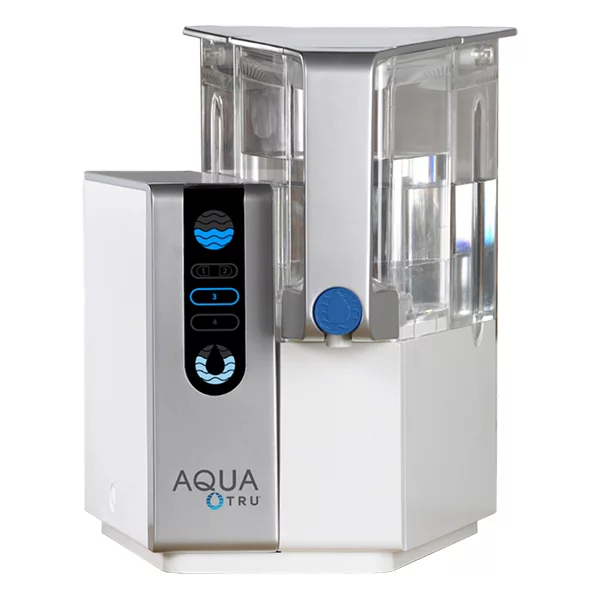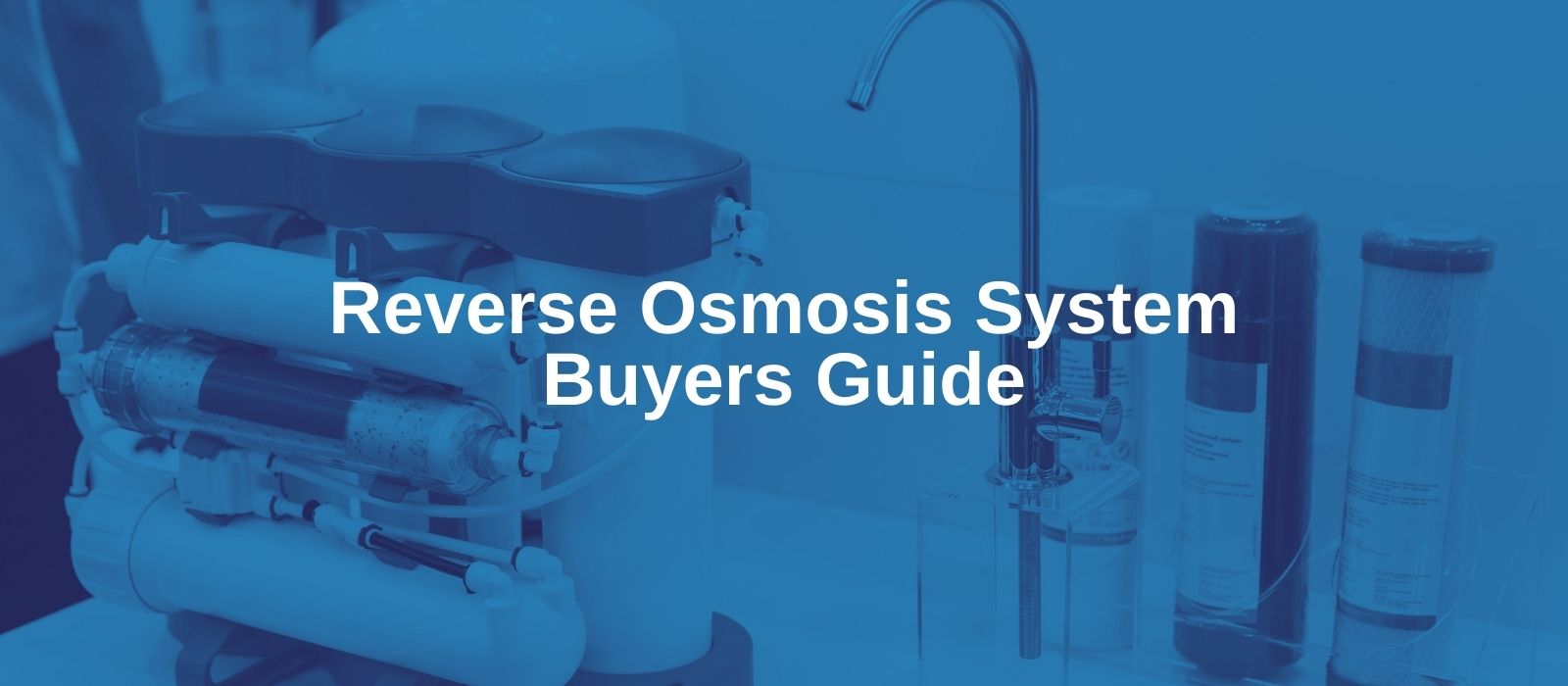Imagine having the same high quality water you get from an under sink reverse osmosis system at the convenience of your countertop.
No more difficult installations. No more lengthy filter changes.

- Price: $$
- Stage: 4
- Certifications: NSF, WQA
- Annual Costs: $89.95
- Special Features: Hot Water, Set Dispense Amounts, Filter Replacement Reminder
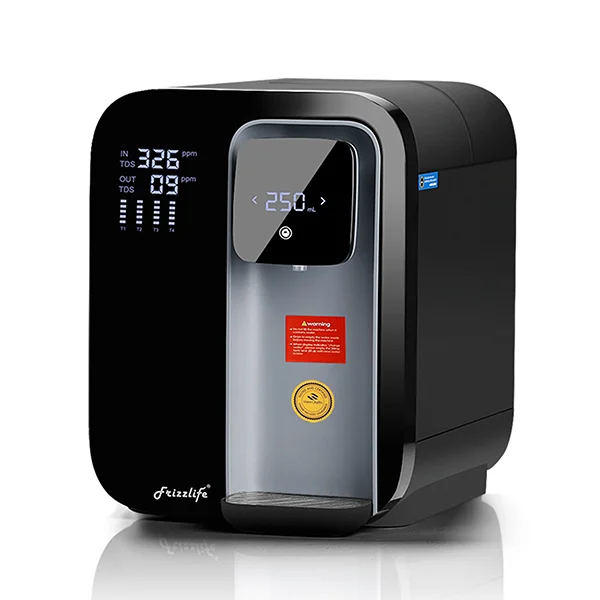
- Price: $$
- Stage: 4
- Certifications: NSF
- Annual Costs: $110
- Special Features: Set Dispense Amount, Filter Reminders
- 1. NU Aqua 4 Stage Countertop Reverse Osmosis System
- 2. Frizzlife WA99 Countertop Reverse Osmosis System
- 3. AquaTru Countertop RO System
- Counter Top Reverse Osmosis System Buyer’s Guide
- FAQ
1. NU Aqua 4 Stage Countertop Reverse Osmosis System
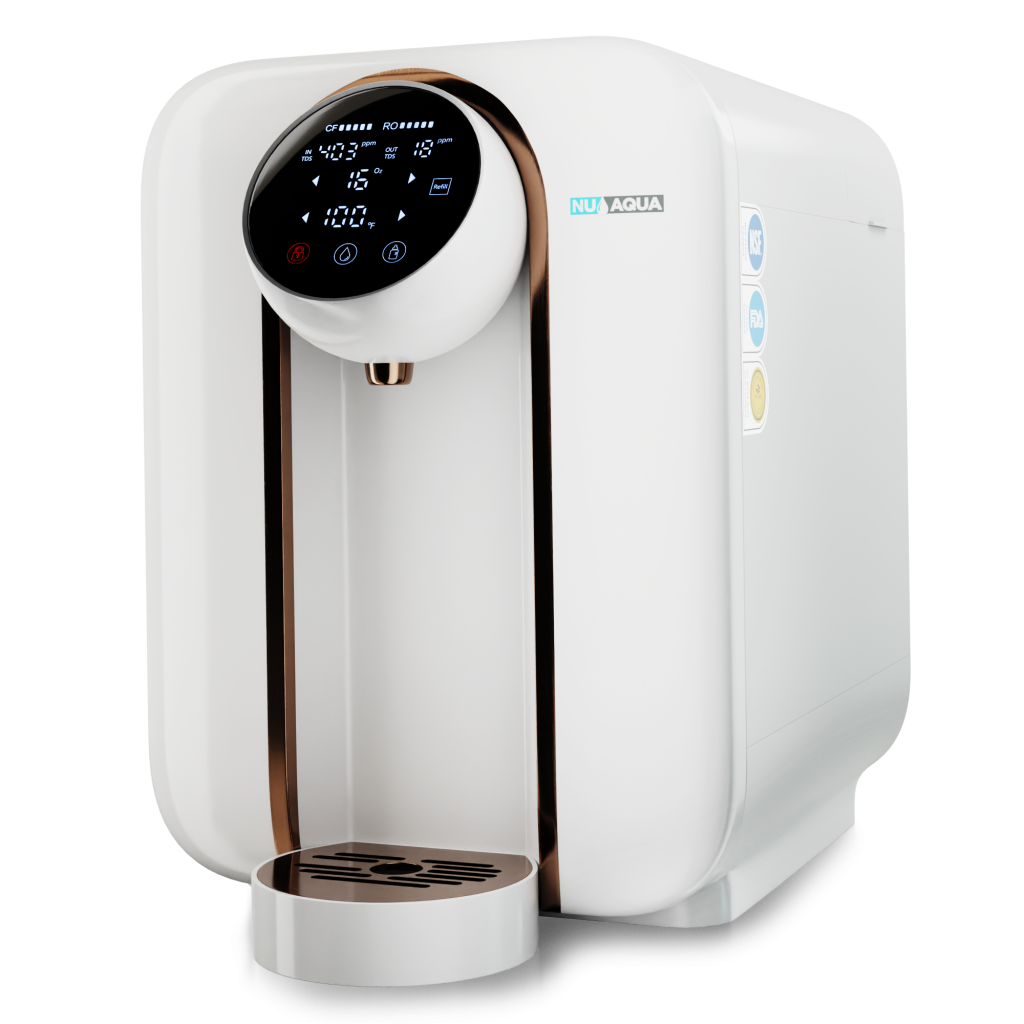
In my opinion NU Aqua is by far the top choice if you’re in the market for a countertop reverse osmosis system.
First thing I noticed about this system is the elegant design that matched perfectly with my other appliances.
The body of the system feels solid and seems to be made from a quality material.
Tested and certified by WQA and NSF so you know you’re getting quality drinking water and the display on the system provides you accurate information about the total dissolved solids in the raw and filtered water.
Under the rear hood of the system you can access both water storage tanks, the purified and unfiltered water. The unfiltered tank holds 16 cups and I found this to be enough for my home of three to last roughly a day.
Filter changes are extremely easy. They install vertically into the system and lock in place with a short turn.
The first filter is a sediment and carbon filter that lasts about 9-12 months. Stage 2 is RO membrane that is combined with carbon as well. This filter will last about 18-24 months.
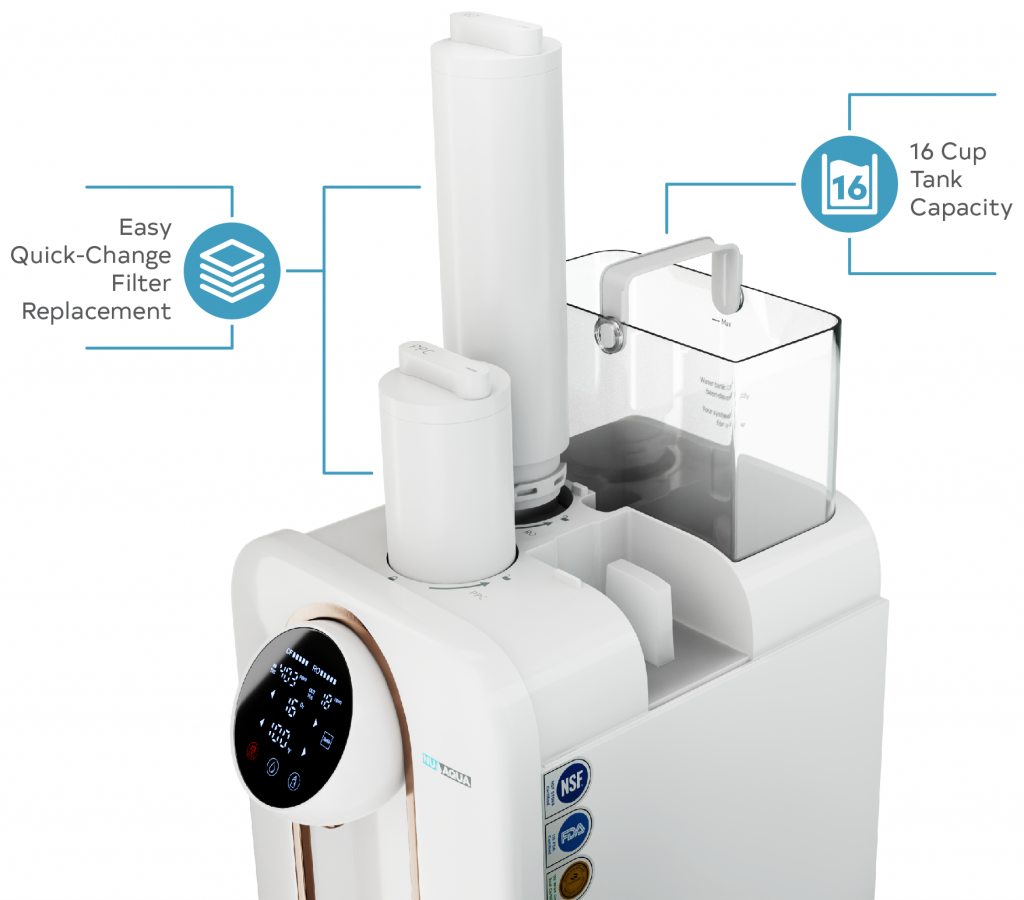
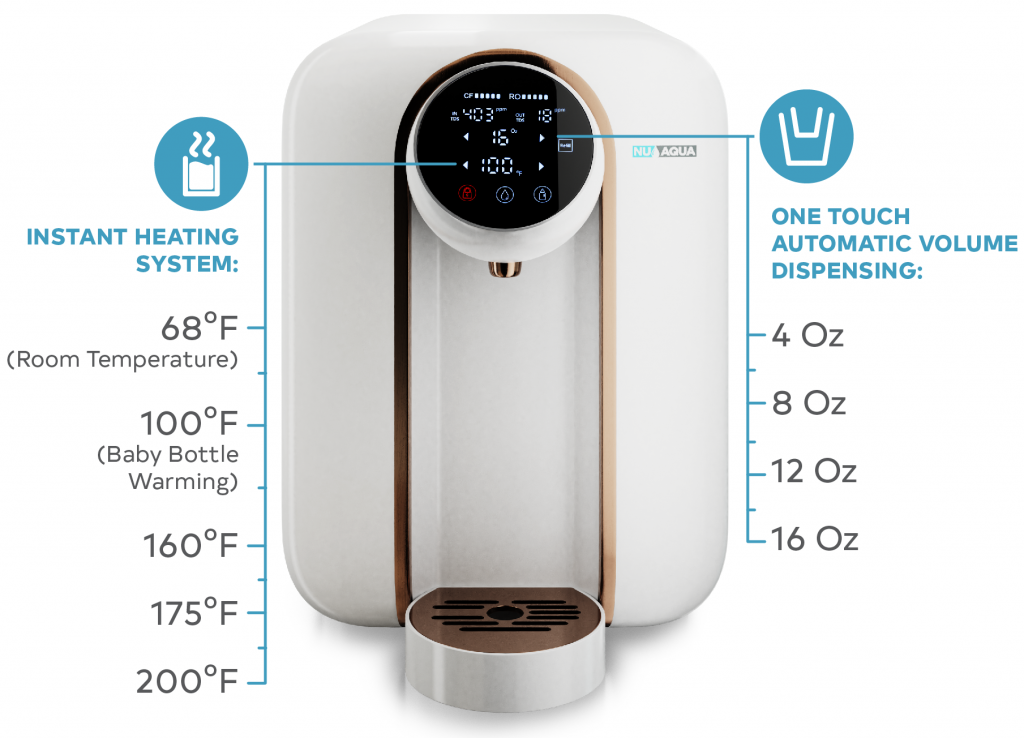
One thing that is nice about the NU Aqua countertop RO system is the display. It’s simple to understand and is bright enough to be read even with bright kitchen lights turned on.
The main feature that sets this system apart from others is the hot water function. At the push of a button you get instant hot water.
You can select the temperature from room temperature, 100°F, 160°F, and 200°F. If you’re like me and constantly drinking tea throughout the day this is a system you will surely appreciate.
- Dispenses hot water on demand
- Reasonably priced for the features
- NSF & WQA Certified
- Smart display for TDS reading
- Filter life indicator
- Only available in white
- Requires emptying water tank periodically
2. Frizzlife WA99 Countertop Reverse Osmosis System
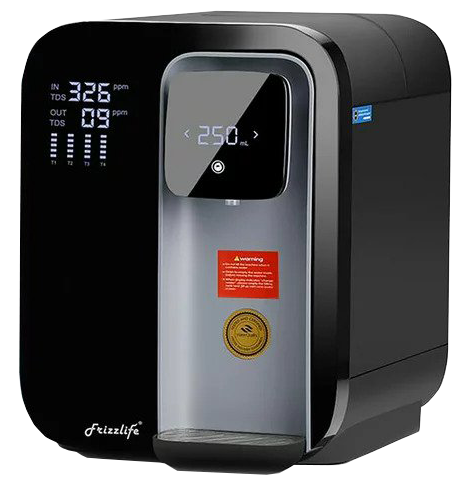
If you’re in the market for a countertop reverse osmosis system and don’t need hot water the Frizzlife WA99 countertop system is a great option.
Like the NU Aqua countertop system, the Frizzlife also features four stages of filtration.
I find the digital display bright and easy to read. The display includes the TDS of the water and the remaining life of the filters.
When it comes time to change your water, the tank is easily removed from the back of the system.
The system is also very efficient. It provides a 5:1 pure to waste ration.
One thing that could be improved is the color choices. Having a black appliance on your countertop may not always look the best. In most kitchens having a more neutral color like white seems to fit much better.
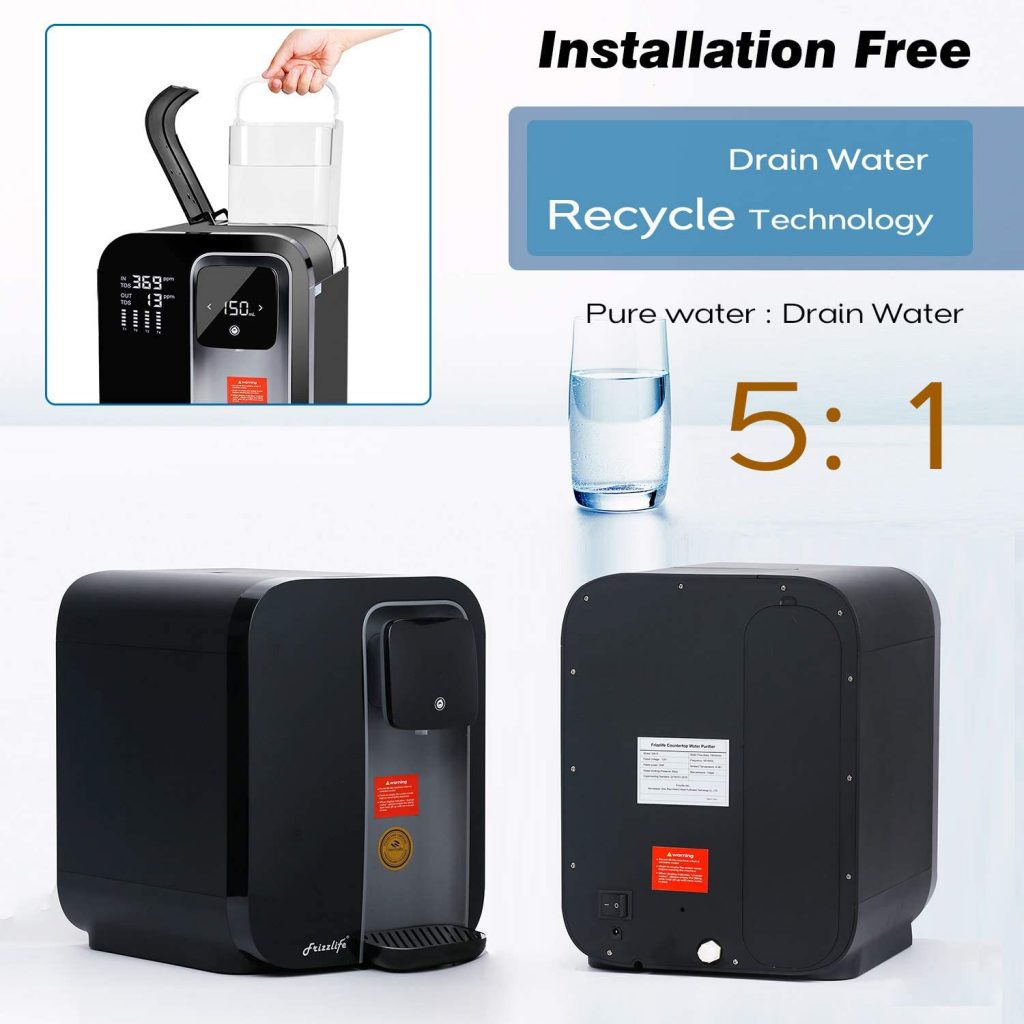
Overall the Frizzlife countertop RO system is an effective solution for anyone looking to ditch bottled water but can’t install a full reverse osmosis system. If you’re not looking for hot water this may be the best option for you.
- Sleek design
- 5:1 waste ratio
- NSF & WQA Certified
- Smart display for TDS reading
- Filter life indicator
- Filter life is short
- Costly filter replacements
- difficult instructions
3. AquaTru Countertop RO System

Aquatru’s countertop reverse osmosis system is one that has been around for the longest time and has gone through many updates.
Don’t let its older design fool you, this system is highly effective at providing great tasting drinking water.
With 3 stages of filtration you can be sure the water you’re drinking is of the best quality.
One thing that really sets the Aquatru apart is the ability to remove the processed water tank. This acts like a water pitcher that can be easily stored in the refrigerator to keep it cool.
Dispensing water from the system is fairly straightforward. At the push of a button water dispenses from the storage tank directly into your glass.
A feature that’s nice is the filter replacement reminder located on the front of the system. However, unlike the NU Aqua or Frizzlife system there is no TDS reading.


Under the hood of the system you will find three vertical filters that can be easily changed when the time comes.
Overall the system is smaller in size than the others on the list but still effectively filters your water.
The design is modern and sleek and will look right at home on your counter alongside your other appliances.
- Removable water tank can be put into refrigerator
- Filter change alerts
- Compact design
- Fragile and easily broken
- Prone to leaks
- No TDS reading
Counter Top Reverse Osmosis System Buyer’s Guide
Countertop reverse osmosis systems require minimal or no installation. They often come with features that are not available with under sink systems such as heated water, preset dispense amounts, and water quality monitoring.
In this guide we will explore what countertop reverse osmosis systems are and what makes them such a good alternative to other water filtration systems.
Factors to consider when purchasing a countertop reverse osmosis system?
Purchasing a countertop system can be a pricey investment upfront but in the long run can save you money. This is only true if you purchase a quality system that meets your home’s needs.
Water Source
When it comes to the water that’s supplied to your home it most likely comes from one of two sources. City water or well water.
City water is provided to your home from a municipal water treatment plant. This is where your water is often treated with chlorine, and fluoride. Two of the contaminants we want to remove from the water we drink.
When water is treated with chlorine this kills the bacteria and viruses that may be in the water. Which is one thing countertop reverse osmosis systems cannot remove since they do not feature UV sterilization.
This is why a countertop system is best for homes that are provided water from the city.
If your home is on a well, the water direct from that well would not be safe to use in a countertop reverse osmosis system.
However, If you already have a whole home UV filter installed or some type of sterilization system then it would be safe.
Basically, if you’re on city water a countertop system is a great option. If you’re on a well you may need a system with UV protection if you don’t have something installed already.
Countertop Space
Another factor to consider when looking for a countertop system is space.
Now that there are so many new appliances, my countertop space has begun to dwindle as I am sure yours has too.
Always make sure you have a space selected that is close to an electrical outlet so you don’t have to run an unsightly extension cord across your countertop.
One more thing to consider is the look and design of your kitchen and how will your new system fit in. The last thing you want is some awkward colored appliances taking up valuable cooking real estate.
Water Demand
Depending on how many live in your house will determine your water needs. Most countertop systems will be sufficient to provide enough water for a house up to five. However, anything over 5 you may find yourself needing to refill the system more frequently.
Replacement Costs
The initial investment of the system won’t be the only cost associated with owning a countertop reverse osmosis system. On average you will need to be replacing your filters every 6-12 months depending on the system.
Why choose a countertop reverse osmosis system instead of a under sink or whole house?
Every home is different when it comes to their water needs and requirements. But one thing is certain. Every home needs access to clean drinking water.
Countertop reverse osmosis systems have been the answer for those who live in apartments, RVs, or rentals. Since they do not require any installation aside from plugging the system in and adding water.
Unless you’re a homeowner, it’s probably not the best idea to make any modifications to your home that could be costly to remove or potentially damaging.
In some cases you might be able to come to an agreement with your landlord to have one professionally installed but in the end that’s more money out of your pocket.
Undersink and whole home systems are the best option for drinking water but like stated above require installation that is not entirely reversible or at least easily.
What makes a countertop reverse osmosis system better than another?
When just taking a quick glance at all the countertop options available they all seem very similar but that couldn’t be farther from the truth.
The Look of the system is just a small aspect of what makes a system better than one another.
One thing to look at is the features.
Does this system have hot water?
Does it provide detailed information about the water quality?
Does the system inform you when you need to change the filters?
How expensive are the replacement filters?
What kind of warranty does the system have?
This may not be everything, but these are some of the questions that you should be asking when shopping for your next countertop reverse osmosis system.
Maintenance
One thing is for sure, you certainly have to keep your system clean.
Fortunately, countertop systems require minimal maintenance.
Cleaning
One thing is for sure, you certainly have to keep your system clean.
This includes the exterior body but also the water storage tanks. If you let the water sit for too long it’s best to empty the tanks and clean them with soap and water.
Filter changes
If you want your water to taste great every time you have a drink you need to make sure you keep up to date with your filter changes.
Most systems available will have some kind of indicator that will tell you if you need to replace one of your filters or if they’re getting close to needing replacement.
Listen to your system when it gives these warnings or you might end up with a bad tasting glass of water.
FAQ
Is reverse osmosis water just as good as distilled water?
Yes, and in fact it’s a more effective way to filter your water.
Both methods can provide clean drinking water by removing dissolved solid and minerals. However, distilled water does not remove volatile chemicals such as chloramines.
Another benefit to reverse osmosis is the filtration rate. Distillation is a slow process and takes a long time to provide a sufficient amount of purified water.
Does reverse osmosis water taste good?
When it comes to the taste of water it’s very subjective. I’ve tasted over 100 different types and brands of water and each one is slightly different.
Most bottled water companies add specific minerals to their water for taste. This is how each brand of bottled water tastes different even though most are processed the same way using reverse osmosis.
Reverse osmosis is highly effective at removing contaminants but it also removes those minerals that provide tastes.
I personally find reverse osmosis water to have a very clean and refreshing taste. However, some people find it lacking taste.
Fortunately, if you do not like the taste there are options to add back minerals to reverse osmosis water. For an undersink system you can add a remineralization filter as a final filter before the faucet.
If you have a countertop system there are mineral and electrolyte blends that come in a drop bottle that can be added to your glass of water. This will change the taste of your water as well as give you the benefit of drinking electrolytes.
Does a countertop reverse osmosis system perform the same as a under sink system?
Yes, countertop systems are just as effective as a traditional style undersink reverse osmosis system.
Just like an undersink system, these countertop systems usually feature a sediment filter, a couple carbon filters, and a reverse osmosis membrane.
The main difference between the two styles of systems is the way water enters the system. With an undersink system water is provided directly from your home’s plumbing system, whereas a countertop system requires the water storage tank to be filled from a faucet.
Ben Jordan has over 10 years of experience working in the water treatment industry and has a bachelors degree in water management. Water is his passion and in his free time he’s an aquarist that maintains large saltwater aquariums.

